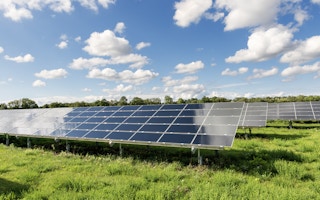Observers might be forgiven for thinking that so-called clean technology’s moment in the sun has passed. Over the last two years, many clean-tech equity indexes have performed poorly. In Europe, solar power took a hit after the European Commission decided to phase out subsidies for renewable energy by 2017. The installation of solar panels fell by nearly 60 per cent in Germany in 2013, and by 70 per cent in Italy. Meanwhile, in the United Kingdom, less than 30 per cent of early-stage venture-capital-funded clean-tech deals were financed.
To continue reading, subscribe to Eco‑Business.
There's something for everyone. We offer a range of subscription plans.
- Access our stories and receive our Insights Weekly newsletter with the free EB Member plan.
- Unlock unlimited access to our content and archive with EB Circle.
- Publish your content with EB Premium.
The truth is that we have been here before. The convulsions in the clean-tech sector are simply symptoms of a cycle that characterizes emerging technologies: excitement, inflated expectations, and consolidation – ultimately followed by stability and the resumption of growth. Indeed, underlying recent developments are signs of a much more significant transformation: clean tech is becoming commercially viable.
Confidence in the clean-tech sector’s future is rooted in the need for sustainable solutions for a planet that is supporting an ever-wealthier population. Over the next 20 years, the number of middle-class consumers is expected to rise to some three billion, from 1.8 billion today. Their new lifestyles will require resources, including energy.
This surge in demand will occur at a time when finding, developing, and extracting new sources of energy and resources will be increasingly challenging and expensive. Over the last 12 years, for example, the average real construction cost of an oil well has doubled, and in recent years new mining discoveries have been few, despite the industry’s best (and often expensive) efforts. But clean-energy costs are trending in the opposite direction, ripening these solutions at a time when need – particularly in some of the world’s largest developing cities – is becoming acute.
One pivotal question for the future of clean tech has been whether it needs regulatory support to thrive. To be sure, the withdrawal of subsidies in Europe hit the sector hard. But, even as Germany and Italy lost their first- and second-place rankings in terms of new solar-power installations, China and Japan took their place. Globally, the solar-power industry has grown at an average annual rate of 57 per cent since 2006.
Regulatory support has been effective in creating demand and allowing sources of renewable supply to reach scale. But such support has not always been economically efficient. One lesson from the German experience is that sudden changes in regulation can create peaks and valleys in demand that are not helpful to an industry that is still emerging. The biggest risk in many markets is not that subsidies and other supports will be withdrawn, but that the regulatory structure will not adapt as the sector develops.
“
A thriving global marketplace goes a long way toward leveling the playing field across all resource options. During the last five years, dozens of solar manufacturing companies have failed, only to be replaced by stronger, more innovative, and more efficient players.
As industries mature, the case for policy support weakens. And, indeed, solar power increasingly appears to be able to survive without regulatory help.
A thriving global marketplace goes a long way toward leveling the playing field across all resource options. During the last five years, dozens of solar manufacturing companies have failed, only to be replaced by stronger, more innovative, and more efficient players. More than one-quarter of cumulative global solar photovoltaic capacity was installed just in the past year. The International Energy Agency, which has been conservative regarding solar energy’s prospects, now expects it to be the world’s largest power source by 2050.
Nonetheless, concerns about the future of clean tech have made new projects more difficult to finance. But innovative new schemes, such as clean-tech bonds and third-party financing, are changing the picture. Third-party ownership, in which a company installs and maintains solar panels, in exchange for either a set monthly rate or a fixed price per unit of power, has driven up adoption rates in California, financing more than two-thirds of new installations in 2012 and 2013. Similarly, new partnerships with large industry incumbents – such as the tie-up between Daimler and Tesla and the controlling stake that Total took in SunPower – are reducing the cost of finance for smaller firms.
Meanwhile, clean-tech companies are becoming more sophisticated and creative. An entire new industry has been created around the use of information technology to reduce energy consumption. Some companies, such as C3 Energy, offer electric utilities software that can analyze their electrical networks to improve grid operations and asset utilization, thereby increasing profits.
Smart-grid hardware has been deployed widely in the past decade, and as companies figure out how to use big data and analytic tools, it will become much more important. Google’s acquisition of Nest Labs for $3.2 billion is a good example of the value that companies are placing on this kind of data.
All of this adds up to an industry that Bloomberg calculates reached $310 billion in investment last year. This is not a “niche” segment, but an asset-intensive industry on its way to commoditization.
Clean tech is maturing and adopting proven management practices in operations, marketing, sales, and distribution. Increasingly, the industry is implementing approaches that have ensured success in other sectors, such as reducing procurement costs and deploying lean principles in manufacturing. As clean-tech businesses continue to scale up, there will be additional opportunities to improve.
The shakeout in the clean-tech industry has been tough; but it has also been typical of emerging technologies, and, by weeding out the weaker players, it has made the sector more robust. This is a global segment meeting a growing global need. There is little room for doubt that the clean-tech industry can expect plenty of sunny days ahead.
Jon Creyts is a managing director at Rocky Mountain Institute. Martin Stuchtey is Director of the McKinsey Center for Business & Environment.
Copyright: Project Syndicate, 2015.
www.project-syndicate.org









